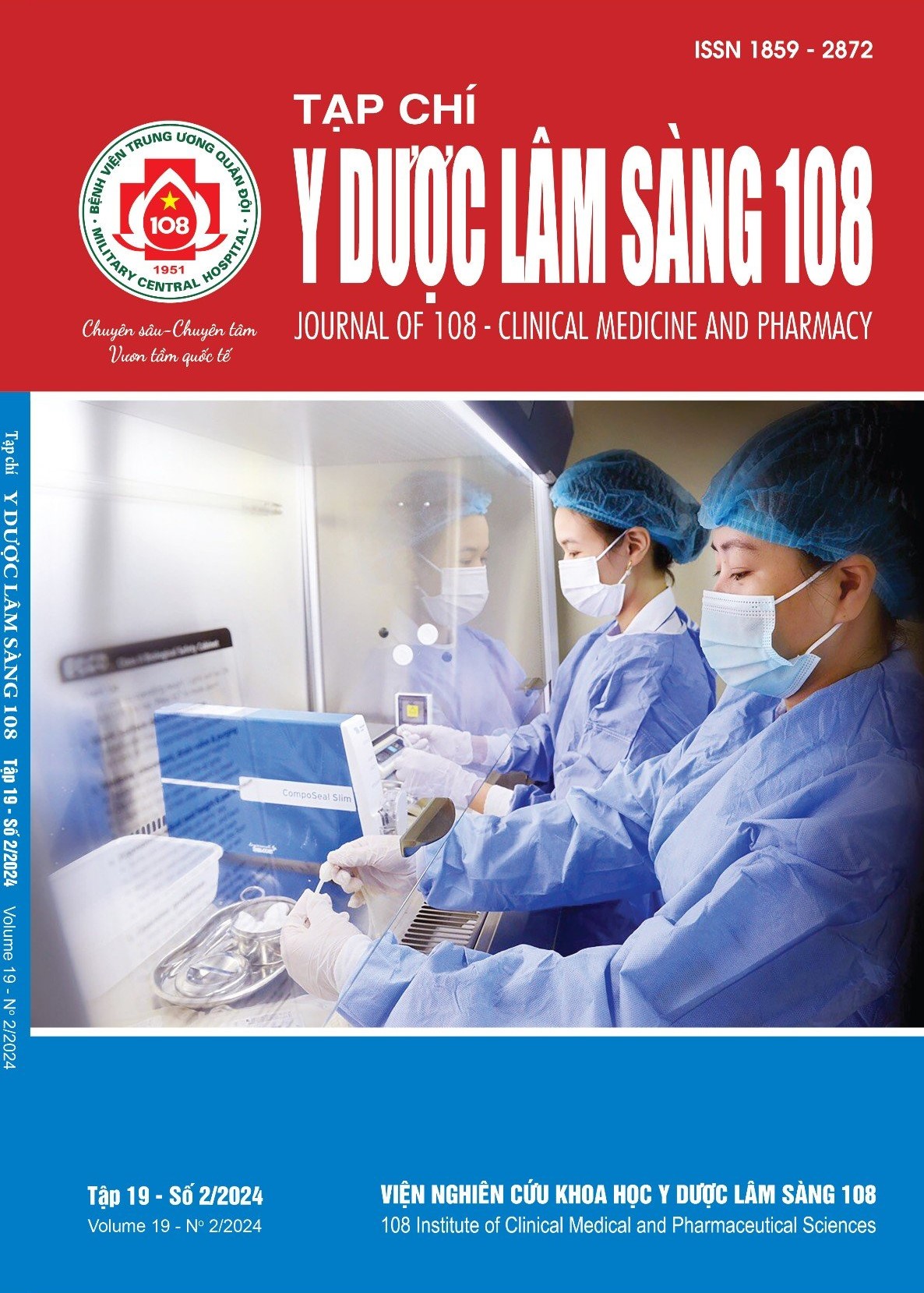Đặc điểm lâm sàng, cận lâm sàng và kết quả điều trị ở bệnh nhân nhiễm giun lươn tại Bệnh viện Đại học Y Dược Thành phố Hồ Chí Minh
Main Article Content
Keywords
Tóm tắt
Mục tiêu: Mô tả đặc điểm lâm sàng, cận lâm sàng, và kết cục điều trị bệnh nhiễm giun lươn nhằm giúp bác sĩ lâm sàng nhận diện sớm bệnh lý này. Đối tượng và phương pháp: Nghiên cứu hồi cứu trên những bệnh nhân bị nhiễm giun lươn, điều trị tại Khoa Tiêu hóa, Bệnh viện Đại Học Y Dược thành phố Hồ Chí Minh. Các thông tin về triệu chứng lâm sàng, đặc điểm cận lâm sàng, điều trị và theo dõi sau điều trị được ghi nhận và phân tích. Kết quả: Có 163 bệnh nhân thỏa tiêu chí nghiên cứu. Đau bụng (63,2%), nôn ói (50,3%), tiêu chảy (46%) và mệt mỏi (76,7%) là bốn triệu chứng thường gặp nhất. Tình trạng suy giảm miễn dịch dường như là yếu tố nguy cơ của bệnh giun lươn khi hiện diện ở gần 2/3 trường hợp (64,4%). Trong đó, việc sử dụng steroids kéo dài dẫn đến suy thượng thận mạn tính thường gặp nhất (23,3%). Hơn một nửa số bệnh nhân có tăng eosinophil máu ngoại biên và giảm albumin (57,1% và 65% theo thứ tự). Ngoài ra, 17,3% bệnh nhân có tình trạng giảm natri máu nặng. Về điều trị, đa số bệnh nhân đáp ứng tốt với ivermectin, ngoại trừ 17 trường hợp tử vong (10,4%). Kết luận: Bệnh nhiễm giun lươn nên được nghĩ đến ở những bệnh nhân nhiều bệnh nền, đặc biệt có tình trạng suy giảm miễn dịch, có biểu hiện triệu chứng tiêu hóa, xét nghiệm ghi nhận giảm albumin và hạ natri máu.
Article Details
Các tài liệu tham khảo
2. Nutman TB (2017) Human infection with strongyloides stercoralis and other related strongyloides species. Parasitology 144(3): 263-273.
3. Czeresnia JM, Weiss LM (2022) Strongyloides stercoralis. Lung 200: 141-148.
4. Farthing M, Albonico M, Bisoffi Z, Bundy D, Buonfrate D, Chiodini P, Katelaris P, Kelly P, Savioli L, Mair AL (2020) World gastroenterology organisation global guidelines: Management of strongyloidiasis February 2018-compact version.
J Clin Gastroenterol 54(9): 747-757.
5. Mejia R, Nutman TB (2012) Screening, prevention, and treatment for hyperinfection syndrome and disseminated infections caused by Strongyloides stercoralis. Curr Opin Infect Dis 25(4): 458-463.
6. Puthiyakunnon S, Boddu S, Li Y, Zhou X, Wang C,
Li J and Chen X (2014) Strongyloidiasis - an insight into its global prevalence and management.
PLoS Neglected Tropical Diseases 8: 3018.
7. Schär F, Giardina F, Khieu V, Muth S, Vounatsou P, Marti H and Odermatt P (2016) Occurrence of and risk factors for strongyloides stercoralis infection in south-east Asia. Acta Tropica 159: 227-238.
8. Senephansiri P, Laummaunwai P, Laymanivong S and Boonmar T (2017) Status and risk factors of Strongyloides stercoralis infection in rural communities of Xayaburi Province, Lao PDR. Korean Journal of Parasitology 55: 569-573.
9. Lê Đức Vinh (2019) Nghiên cứu thực trạng, một số́ yế́u tố́ liên quan đến nhiễm giun lươn Strongyloides spp và kết quả điề̀u trị bằng ivermectin tại huyện
Đức Hòa tỉnh Long An (2017 - 2018). Luận án tiến sĩ y học, Đại học Y Hà Nội.
10. Centers for Disease Control and Prevention. Parasites Strongyloides. Resources for health professionals [Internet]. Atlanta, GA: Centers for Disease Control and Prevention; 2016 [accessed 2018 Mar 13].
11. Chan AHE, Kusolsuk T, Watthanakulpanich D, Pakdee W, Doanh PN, Yasin AM, Dekumyoy P, Thaenkham U (2023) Prevalence of Strongyloides in Southeast Asia: A systematic review and
meta-analysis with implications for public health and sustainable control strategies. Infect Dis Poverty 12(1): 83.
12. Buonfrate D, Baldissera M, Abrescia F, Bassetti M, Caramaschi G, Giobbia M, Mascarello M, Rodari P, Scattolo N, Napoletano G, Bisoffi Z; CCM Strongyloides Study Group (2016) Epidemiology of Strongyloides stercoralis in northern Italy: Results of a multicentre case-control study, February 2013 to July 2014. Euro Surveill 21(31):30310. doi: 10.2807/1560-7917.ES.2016.21.31.30310.
13. Khieu V, Srey S, Schär F, Muth S, Marti H,
Odermatt P (2013) Strongyloides stercoralis is a cause of abdominal pain, diarrhea and urticaria in rural Cambodia. BMC Res Notes 6: 200. Published 2013 May 20.
14. Krolewiecki A, Nutman TB (2019) Strongyloidiasis:
A neglected tropical disease. Infect Dis Clin North Am 33(1): 135-151.
15. Chowdhury DN, Dhadham GC, Shah A, Baddoura W (2014) Syndrome of inappropriate antidiuretic hormone secretion (SIADH) in strongyloides stercoralis hyperinfection. J Glob Infect Dis 6(1):
23-27.
16. Vandebosch S, Mana F, Goossens A, Urbain D (2008) Strongyloides stercoralis infection associated with repetitive bacterial meningitis and SIADH:
A case report. Acta Gastroenterol Belg 71: 413-417.
17. El Hajj W, Nakad G, Abou Rached A (2016) Protein Loosing Enteropathy Secondary to Strongyloidiasis: Case Report and Review of the Literature. Case Rep Gastrointest Med: 6831854.
18. Wang Y, Zhang X (2023) Gastroduodenal strongyloidiasis infection causing protein-losing enteropathy: A case report and review of the literature. Heliyon 9(7): 18094.
 ISSN: 1859 - 2872
ISSN: 1859 - 2872
